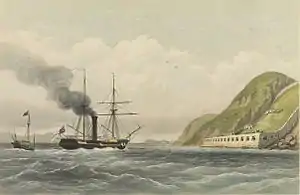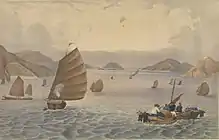 Vulture passing the Bogue on the way to Hong Kong after the Expedition to Canton, 9 April 1847 | |
| History | |
|---|---|
| Name | Vulture |
| Ordered | 18 March 1841 |
| Builder | Pembroke Dockyard |
| Laid down | September 1841 |
| Launched | 21 September 1843 |
| Decommissioned | 1866 |
| General characteristics | |
| Displacement | 1,960 long tons |
| Complement | 175 |
| Armament | 6 × guns |
HMS Vulture was one of three 6-gun, steam-powered Cyclops-class second-class paddle frigates built for the Royal Navy in the 1840s. She was initially deployed to the East Indies where she participated in actions against China and then played a minor role in the Crimean War of 1854–1855. The ship was sold for scrap in 1863.
Design and construction
Vulture had a length at the gun deck of 190 feet 1 inch (57.94 m) and 163 feet 6 inches (49.8 m) at the keel. She had a beam of 37 feet 6 inches (11.4 m), and a depth of hold of 23 feet (7.0 m). The ship's tonnage was 1,19055⁄94 tons burthen and she displaced 1,960 long tons (1,990 t). Her crew numbered 175–195 officers and ratings.[1]
The ship was fitted with a pair of steam engines rated at 476 nominal horsepower, that had two vertical cylinders of 80-inch (200 cm) diameter with 5 ft 9 in (1.75 m) stroke, that used steam provided by four boilers. The paddle wheels were 26 ft 6 in (8.08 m) diameter to the extremity of the floats, which were 8 ft 9 in (2.67 m) wide.[2] Vulture carried six guns – two 8-inch guns of 95 cwt[Note 1] mounted on pivots at bow and stern, and four 8-inch guns of 65 cwt on broadside trucks.[3]
She was launched on 21 September 1843 and was then fitted with Fairbairn engines in the East India Docks until 23 January 1844. She had cost £24,323 to build and £22,395 to fit out (including £21,429 for the 476 nhp engines). Vulture was first commissioned in February 1845 for the East Indies, and completed fitting for sea (for a further £9,173) at Sheerness Dockyard until 7 June 1845.[1]
Career
She was involved in the Expedition to Canton of 1847. She paid off on return from the East Indies that same year, and then underwent a small repair at Sheerness and Woolwich in 1848–1849 (for £17,334). She was recommissioned in November 1852[1] and was used in the Baltic theatre of the Crimean War in 1854. She was in action with the Russians on 7 June 1854, in the action at Gamla Carleby, Finland.[4] On 27 August 1855, she ran aground off Hanko Head, Grand Duchy of Finland whilst towing a vessel from Nargen to Farosund. She was severely damaged and was sent back to England for repairs.[5] In February 1859, she ran aground on the Barbary Coast. Vulture was refloated and escorted by HMS Perseverance to Malta, where she arrived on 21 February in a leaky condition.[6] She was recommissioned again in December 1859 for service in the Mediterranean. The ship was paid off on 5 April 1860, and laid up at Portsmouth. She was sold to Castle & Son, Charlton for scrap in October 1863.[1]

_RMG_PU0175.tiff.jpg.webp)
Notes
- ↑ "Cwt" is the abbreviation for hundredweight, 56 cwt referring to the weight of the gun.
Citations
- 1 2 3 4 Winfield, p. 1216
- ↑ "Engines of Her Majesty's steam frigate, the Vulture", The Practical Mechanic and Engineer's Magazine, July 1844, p. 314
- ↑ Lyon & Winfield, p. 151
- ↑ Lambert, Andrew (2004). "Looking for gunboats: British Naval operations in the Gulf of Bothnia, 1854–55". Journal for Maritime Research 6:1, 69, DOI: 10.1080/21533369.2004.9668337
- ↑ "The Attack on Sweaborg". Daily News. No. 2900. London. 4 September 1855.
- ↑ "The Mediterranean Station". Hampshire Advertiser and Salisbury Guardian. No. 1854. Southampton. 12 March 1859. p. 8.
Bibliography
- David Lyon and Rif Winfield, The Sail and Steam Navy List 1815–1889. Chatham Publishing, 2004. ISBN 1-86176-032-9.
- Winfield, Rif (2008). British Warships in the Age of Sail, 1793-1817: Design, Construction, Careers and Fates. Barnsley, UK: Seaforth. ISBN 978-1-84415-700-6.